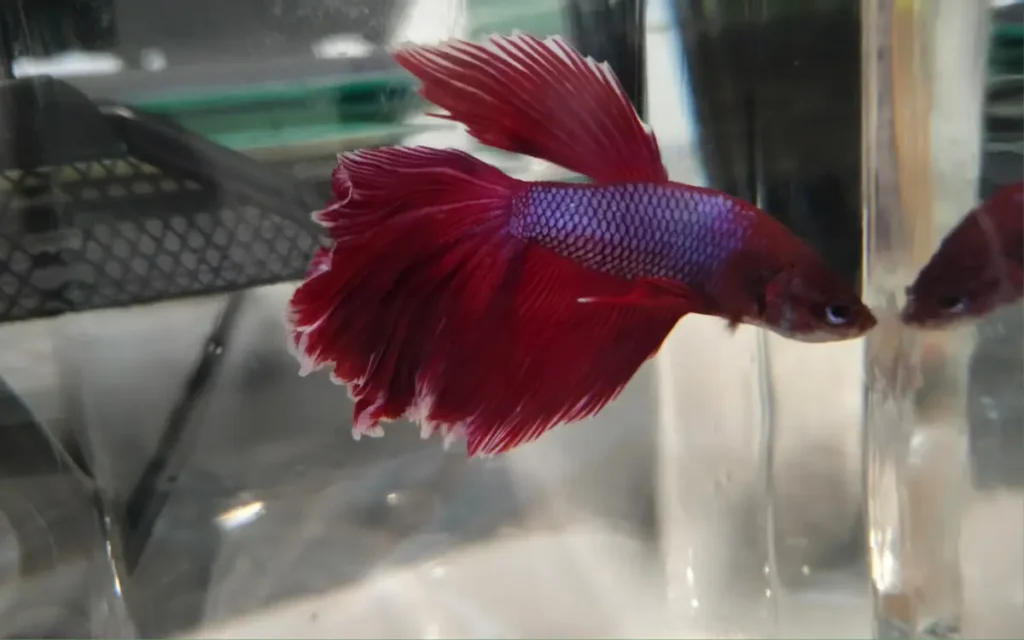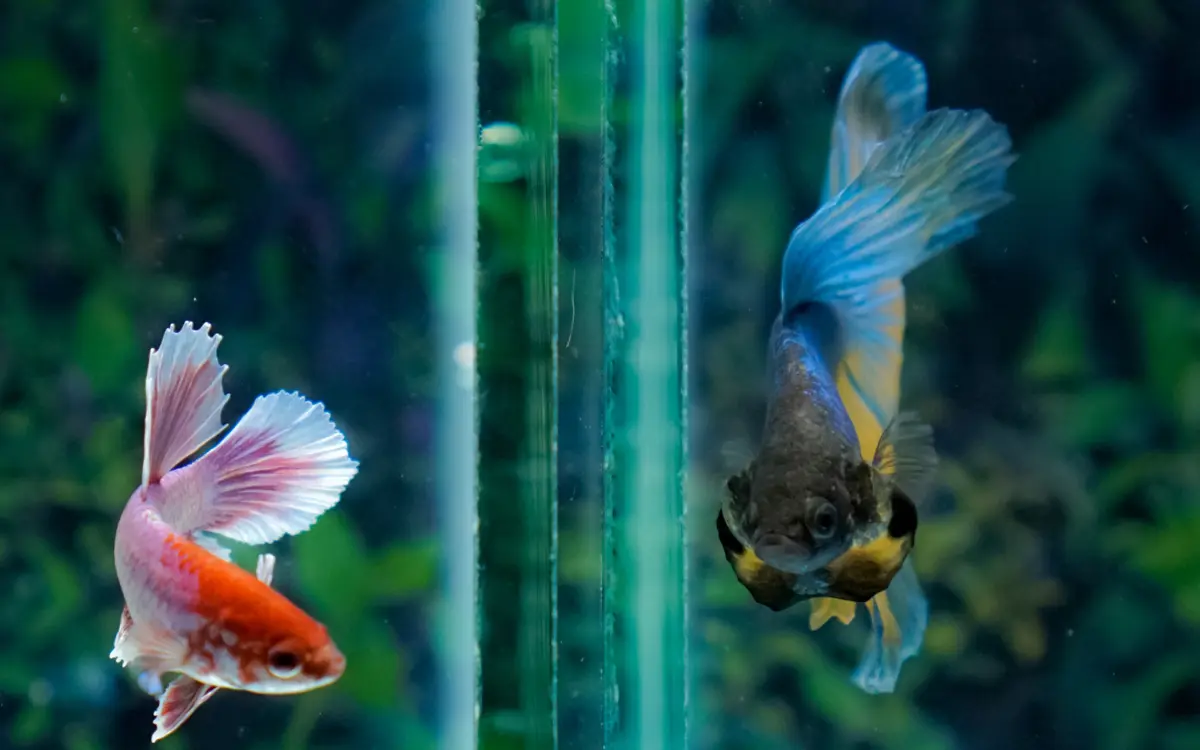Betta fish, admired for their vibrant colors and unique personalities, are a popular choice for aquarium enthusiasts. A common question that arises is whether male and female Betta fish can live together.
The short answer is: not usually, due to their territorial and aggressive nature. However, there are specific situations where it may be possible.
To learn more about the challenges and potential solutions, read the full article for detailed insights on safely housing Betta fish.
Betta Fish Behavior and Temperament
Betta fish, also known as Siamese fighting fish, are renowned for their striking appearance and, equally, their feisty temperament.
Male Bettas, in particular, are highly territorial and aggressive, often displaying combative behavior when they perceive a threat to their space.
This instinct drives them to flare their fins and engage in fights with other fish, especially other males, and sometimes even with females if kept in close proximity.
The behavior of male and female Betta fish differs significantly.
While male Bettas are more aggressive and protective of their territory, female Bettas tend to be slightly less combative but can still exhibit territorial behavior, particularly in small, confined environments.
Despite being less aggressive than males, female Bettas can still become territorial and hostile toward each other and other fish if housed improperly.
Due to these differences and their strong territorial instincts, it is generally not recommended to house male and female Betta fish together, except under controlled breeding conditions.
When forced to coexist, male Bettas may attack the females, leading to stress, injury, or even death, making cohabitation risky in most home aquarium settings.
Potential Risks of Housing Male and Female Betta Together

Housing male and female Betta fish together poses significant risks, primarily due to the aggressive nature of males.
Male Bettas are highly territorial and will often see females as a threat to their space, especially in confined tanks. This territorial aggression can lead to violent interactions, where males may chase, nip, or even attack the female.
The stress of constant pursuit and aggression can severely impact the health of the female Betta, weakening her immune system and making her vulnerable to diseases.
During mating, male Bettas become even more aggressive. While they may initially exhibit courtship behavior, if the female does not respond favorably, the male’s aggression can escalate quickly.
Even after successful breeding, the male may attack the female, mistaking her for a threat to the eggs or fry.
These territorial disputes can result in injuries such as torn fins, bite wounds, or, in extreme cases, fatal outcomes.
The continuous stress and physical harm make cohabitation dangerous for both the male and female Betta.
Without proper precautions, including a large tank, hiding spots, and careful monitoring, the risks of injury or death make keeping them together inadvisable in most home aquariums.
Can Male and Female Betta Fish Live Together Temporarily?
Temporary cohabitation of male and female Betta fish is possible, but only in controlled environments, such as breeding tanks.
During breeding, a male and female Betta may share a tank briefly for mating purposes.
However, this requires careful preparation, including the introduction of a breeding tank with ample hiding spots for the female to retreat from the male’s aggression.
Even in these controlled settings, it is crucial to monitor their interactions closely. After mating, the male will become highly protective of the bubble nest and eggs, often perceiving the female as a threat.
To prevent injury or stress, it is essential to remove the female from the tank immediately after the eggs are fertilized.
This separation helps avoid aggressive behavior from the male and ensures the safety of the female.
Alternatives to Housing Bettas Together
For those who want to house male and female Bettas without the risks of aggression, there are safer alternatives.
One option is to keep them in separate tanks but place them in close proximity, allowing for visual interaction without physical contact.
This setup can help satisfy their natural curiosity while minimizing stress and territorial disputes.
Another option is using community tanks with other peaceful species, like small, non-aggressive fish such as tetras or corydoras.
However, strict monitoring is essential, as both male and female Bettas may still show aggression if provoked or stressed by tank mates.
Lastly, tank dividers offer a practical solution. By dividing a single aquarium with a mesh or solid barrier, Bettas can share the same environment visually but remain physically separated, preventing any direct contact or harm.
This allows for interaction while maintaining safety for both fish.
Breeding Male and Female Bettas
Breeding male and female Betta fish requires careful planning and controlled conditions to ensure their safety.
The breeding process begins by introducing the female into the male’s tank only when both are ready to mate.
Signs of readiness in the male include building a bubble nest at the water’s surface, while the female shows vertical stripes and a distended abdomen indicating she is carrying eggs.
To prepare for breeding, use a separate breeding tank with a minimum size of 10 gallons.
This tank should be equipped with a heater to maintain a temperature of 78-80°F, a gentle filtration system, and plenty of plants or hiding spots for the female to retreat from the male’s advances. A small cup or leaf can help support the bubble nest.
Once introduced, the male will court the female, and if successful, the female will release her eggs, which the male fertilizes and places into the bubble nest. After mating, it is crucial to remove the female from the tank immediately.
The male will become highly protective of the nest and may attack the female, mistaking her for a threat.
Keeping them separated post-breeding ensures the health and safety of both fish, allowing the male to focus on caring for the eggs until they hatch.
Setting Up a Safe Betta Environment
Creating a safe and comfortable environment for Betta fish involves careful attention to tank setup and conditions.
A Betta-friendly tank should be at least 5 gallons in size to give the fish ample space to swim and establish territory.
Bettas thrive with hiding spots, so include decorations like caves, rocks, and live or silk plants that offer both cover and exploration opportunities. Floating plants are also a great addition, as they mimic the Betta’s natural habitat.
To reduce stress, avoid overcrowding the tank and ensure any décor has smooth edges to prevent tearing their delicate fins.
Maintaining a water temperature between 76-80°F is crucial, so using a heater is recommended. Regularly monitor water quality, keeping ammonia and nitrite levels at zero and nitrates under 20 ppm.
Perform partial water changes weekly to ensure a healthy environment. By following these guidelines, you can create a thriving, stress-free home for your Betta.
FAQs
How many Betta fish can live together?
Male Bettas should never be housed together due to their aggressive and territorial nature. However, multiple female Bettas can coexist in what is known as a “sorority,” provided the tank is large enough (at least 20 gallons) with plenty of hiding spots to reduce conflict. Males and females should not live together except during controlled breeding situations.
How can you tell if Betta fish are fighting?
Signs of fighting include aggressive chasing, nipping at fins, flaring gills, and torn fins. If one fish is constantly pursuing the other or there are visible injuries, it’s a sign of conflict, and they should be separated immediately.
What other fish can live with Betta fish?
Peaceful species like small tetras, corydoras, and snails are generally compatible with Betta fish, as long as they don’t nip fins or provoke aggression. Careful monitoring is essential.

